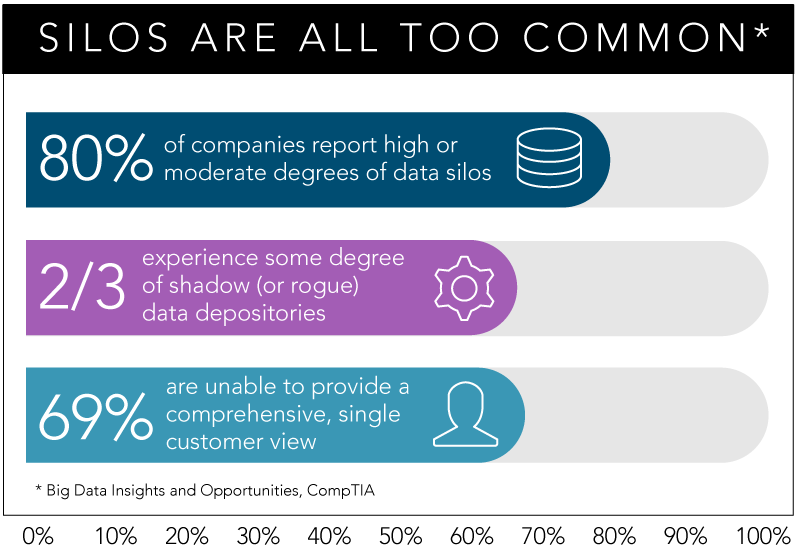In this data-driven world, every business accumulates data at an unprecedented rate. However, this abundance of data comes with challenges, one of the most significant being data silos. Did you know that an average organization employs 129 different applications and systems? This fragmentation creates data silos, hindering collaboration and decision-making processes and often rendering valuable insights inaccessible. This is where data integration can make a difference in your business.
Data integration is the pivotal solution to dismantle these silos and unify your organization’s data landscape. It involves bringing together data from diverse sources, erasing the barriers that hinder its efficient utilization. Integrated data becomes a cohesive and accessible asset, allowing your organization to harness its potential and drive informed decision-making.
Understanding data silos
Picture this: your company resembles a vast library filled with invaluable books of information. However, these books are scattered across shelves, making it difficult to access them. These shelves, analogous to data silos, inhibit the seamless flow of knowledge. Data silos hinder collaboration, stifle efficiency, and impede informed decision-making. They arise for various reasons, such as different departments using disparate systems, lack of data-sharing protocols, or mergers and acquisitions without proper integration strategies.

Imagine how much smoother the operation of our library would be if all books were neatly organized, cataloged, and readily available upon request. Similarly, in a business setting, integrated and accessible data ensures that knowledge flows freely, empowering teams to work harmoniously and make informed decisions swiftly. Different departments within a company often utilize disparate systems to manage their data, resulting in isolated pockets of information. The absence of standardized data-sharing protocols further fuels the creation of these silos. Additionally, mergers and acquisitions introduce new systems and data structures without adequate integration strategies. Consequently, the data from different entities remains segregated and inaccessible, impeding the organization’s ability to function as a unified entity.
Data silos- The unsolved problem in every organization
Data silos are a common issue in many organizations, and their presence can lead to a range of problems that hinder operational efficiency, decision-making, and overall business success.

Understanding the problems associated with data silos is essential to recognize their negative impact and take steps to mitigate them. Here are some key reasons why data silos are problematic:
Inefficient operations
Data silos often lead to redundant processes and wasted resources. When different departments or teams maintain separate data repositories, it can result in duplicated efforts and inefficiencies in data management. Siloed data inhibits collaboration across the organization. Departments may work in isolation, failing to share vital information and insights that could benefit others.
Data inconsistency and compliance issue
Inconsistent data can arise when different departments or systems use their own data definitions and standards. This inconsistency can lead to confusion and errors in analysis and reporting. Data silos can pose security and compliance risks as well, as they may make it challenging to enforce consistent security measures and regulatory compliance across the organization.
Customer experience
When customer data is not readily accessible across various touchpoints, it can result in poor service and missed opportunities to personalize interactions. Without a unified view of data, organizations may miss opportunities for growth, cost savings, or innovation.
Breaking down data silos with data integration solution
A powerful data integration solution acts as a bridge, connecting and unifying data from various sources, formats, and platforms into a cohesive and coherent whole. It is the master key that unlocks these silos, allowing data to flow freely throughout the organization. Imagine data integration as a superhighway connecting all the data islands. It brings about a transformation in data management that is nothing short of revolutionary. Here are some of how data integration can be the catalyst for change in your organization,
Creating a unified data ecosystem
Data integration solution functions as the connective tissue that binds together the diverse data sources within an organization. Data from various departments, systems, applications, and external sources seamlessly combine into a unified data ecosystem. Imagine your data as a puzzle with missing pieces. Data integration is like that final piece that completes the picture. Blending data from diverse sources creates a unified data ecosystem, ensuring everyone in your organization is on the same page. It eliminates data silos and facilitates a smooth, real-time flow of information.
For instance, if a retail giant can seamlessly integrate data from their online sales, in-store transactions, and inventory systems, the retailer can efficiently optimize stock levels and provide consistent product availability information to customers. It can help departments foster a culture of collaboration, efficiency, and innovation.
Enhanced decision-making
Data integration is the beacon that illuminates the path to informed, data-driven decision-making within organizations. In an age where data is amassed in vast quantities and from various sources, it’s easy for decision-makers to feel like they are navigating the dark. Before data integration became a staple in modern business practices, valuable insights often remained obscured within data silos, making it challenging to discern the full scope of an organization’s operations. But with data integration in play, a transformative shift occurs.
Data integration empowers decision-makers by revealing previously hidden connections, patterns, and opportunities. Imagine the CEO of a multinational corporation armed with data integration tools, able to effortlessly access and comprehend real-time data from every corner of the organization, from sales and marketing to finance and customer service. With this comprehensive and holistic view of the data landscape, decision-makers can identify emerging trends, assess the effectiveness of current strategies, and craft well-informed decisions. Whether optimizing supply chain logistics, tailoring marketing campaigns, or managing financial resources, data integration provides the clarity and visibility needed to steer the organization toward its objectives confidently.
Efficient cross-functional collaboration
Departments often operate in isolated silos, working on projects with limited visibility into the broader organizational landscape. These data silos hamper the exchange of crucial information, causing inefficiencies and roadblocks. Data integration solutions transform this fragmented landscape into a harmonious symphony of collaboration. It bridges the gaps between data sources, ensuring that all teams have access to a consistent and up-to-date data set.
With integrated data, departments can efficiently join forces in collaborative projects and initiatives. Marketing can seamlessly tap into sales data, customer service can access the latest product information, and finance can gauge the real-time economic landscape. This seamless exchange of information turbocharges the collaborative process, enabling teams to work together with a shared understanding of organizational goals and strategies. Whether it’s launching a new product, streamlining operations, or devising a customer-focused marketing strategy, data integration is the catalyst that propels cross-functional collaboration to new heights, transforming an organization into a well-oiled, collective powerhouse of productivity and innovation.
Final thoughts
In a nutshell, a data integration solution is the magic wand that breaks down the walls of data silos in your organization. It fuels collaboration, ensures data consistency, and fosters agility across organizations. But, the key is to invest in the right data integration solutions and strategies. It can enable you to harness your data’s full potential, boost efficiency, and thrive in today’s data-centric world. Take a free demo today and accelerate your business success.







